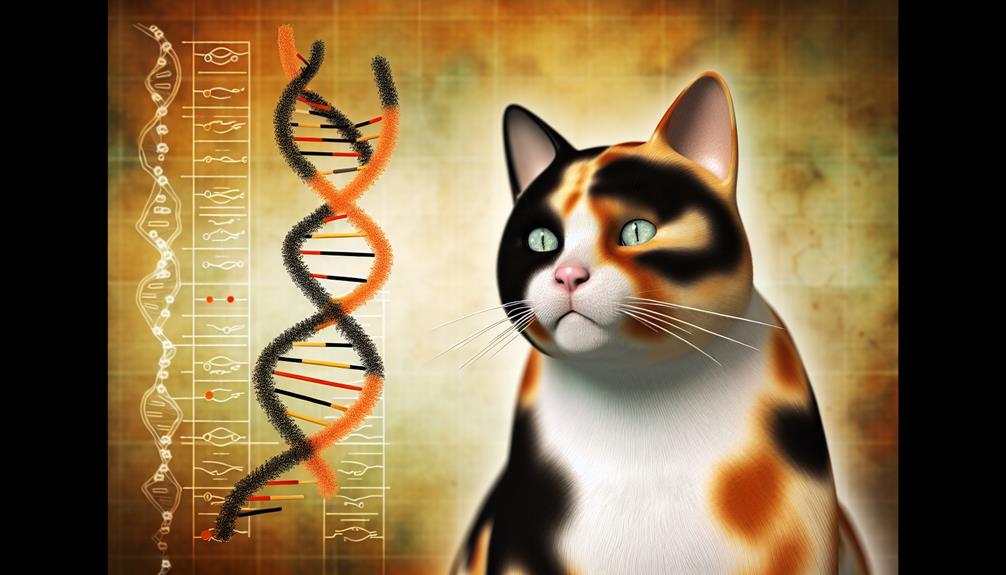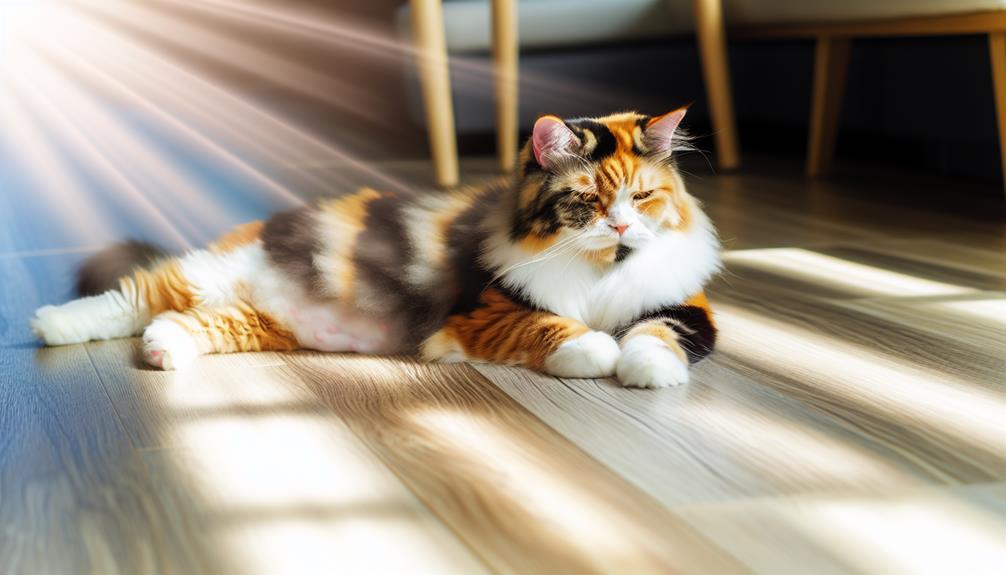Did you know that about 99.9% of calico cats are female? This striking statistic is rooted in genetics, specifically the requirement of two X chromosomes for the distinctive tri-colored pattern. But what about that rare 0.1%? Male calico cats do exist, often due to a genetic anomaly known as Klinefelter syndrome, where they possess an extra X chromosome (XXY). So, what's the story behind these unique males, and how does this genetic twist impact their health and lifespan? Let's explore the fascinating world of calico cats and uncover some surprising facts.
Understanding Calico Cats
Calico cats, frequently recognized by their distinctive tri-colored coats, exhibit a unique genetic phenomenon that piques scientific interest. You've probably noticed their striking patches of white, black, and orange, a combination not attributable to just any cat breed. Instead, calico patterns are a result of intricate genetic mechanisms that manifest differently across various breeds.
When observing calico cats, it is crucial to understand that these patterns aren't exclusive to a single breed. You'll find calico patterns in several cat breeds, including the American Shorthair, Persian, and Maine Coon. The tri-colored fur is not a breed characteristic but rather a coat pattern that can appear in multiple breeds. This phenomenon occurs due to complex interactions between pigment-producing cells and specific genetic codes.
Behaviorally, calico cats don't exhibit traits specific to their coat color. Their behavior aligns more with their breed and individual personality. However, many cat enthusiasts and even some researchers have noted anecdotal evidence suggesting that calicos might possess a distinctively spirited and independent temperament. This observation, though intriguing, lacks rigorous scientific validation.
In terms of clinical terminology, the calico pattern is described as a manifestation of "mosaicism." This term refers to the presence of two or more populations of cells with different genotypes in one individual, originating from a single fertilized egg. Such cellular diversity leads to the fascinating and varied calico patterns you see.
The Role of Genetics
You'll find that the genetic basis for calico coloration hinges on the X chromosomes. The interplay of color genes on these chromosomes results in the characteristic tri-color pattern, primarily seen in females due to their XX chromosomal pair. Male calico cats are rare, typically arising from unusual genetic anomalies such as Klinefelter syndrome (XXY).
X Chromosome Influence
When examining the genetics behind calico cats, it is essential to understand the influence of the X chromosome. This chromosome plays a pivotal role in X chromosome inheritance and as a result, color expression in calico cats. Females typically have two X chromosomes (XX), while males have one X and one Y chromosome (XY). The genes responsible for fur color are located on the X chromosome. Hence, a female cat can inherit two different alleles for fur color, one on each X chromosome. This dual inheritance allows for the distinctive tricolor pattern seen in calico cats.
In contrast, males, possessing only one X chromosome, usually exhibit a single color unless an anomaly such as Klinefelter syndrome occurs, where a male has an extra X chromosome (XXY). This rare genetic condition can result in a male calico cat. The color expression in these felines is a direct outcome of X chromosome inactivation—a process where one of the X chromosomes in each cell randomly deactivates, leading to patches of different colors.
Understanding the X chromosome's role in X chromosome inheritance and color expression elucidates why calico cats are mainly female and underscores the intricate genetic mechanisms at play.
Color Gene Interaction
In understanding the complex interplay of color gene interaction, it is crucial to explore the genetic mechanisms underpinning this phenomenon. At the heart of calico cats' distinctive color patterns lies a fascinating dance of gene expression. The primary genes responsible for coat color in cats are located on the X chromosome. For a cat to exhibit the iconic calico pattern, it must express both black and orange fur, which is dictated by the allelic variants of the X-linked O (orange) gene.
Each cell randomly inactivates one of its X chromosomes in a process known as X-inactivation, leading to a mosaic expression of color. This random silencing results in patches where either the black or orange gene is expressed, creating the characteristic tri-color pattern. The white fur present in calico cats is controlled by a separate gene, which can suppress pigmentation in certain areas.
The genetic intricacy doesn't stop there. The interplay of multiple genes, including those responsible for modifier effects, further refines the color distribution across the cat's coat. Therefore, the unique color patterns of calico cats are a reflection of the complex and elegant choreography of gene expression and interaction.
Male Calico Rarity
Understanding the rarity of male calico cats requires delving into the intricacies of feline genetics. Male cats typically possess one X and one Y chromosome (XY), while females have two X chromosomes (XX). Calico patterns, characterized by a tri-color coat, are a result of the interaction between the X-linked orange and black color genes. For a cat to display calico patterns, it must inherit two X chromosomes, one carrying the orange gene and the other carrying the black gene.
In rare instances, genetic anomalies such as Klinefelter syndrome (XXY) allow male cats to display calico patterns. These males are often sterile due to the extra X chromosome disrupting normal reproductive function. Genetic diversity plays a significant role in these occurrences, though such anomalies are exceedingly uncommon.
| Condition | Chromosomal Pattern |
|---|---|
| Typical Male Cat | XY |
| Typical Female Cat | XX |
| Male Calico (Klinefelter) | XXY |
| Female Calico | XX (with color genes) |
The role of genetics in male calico rarity underscores the importance of chromosomal configurations. Understanding these genetic pathways helps elucidate why male calico cats are so uncommon and highlights the fascinating complexity of feline genetic diversity.
X-Chromosome and Color

Calico cats owe their unique, multicolored coats to the genetic intricacies of the X chromosome. The variation in color combinations—typically a mix of white, black, and orange—stems from a process called X-inactivation. Each cell in a female cat has two X chromosomes, but only one is active in any given cell. The inactivation of one X chromosome leads to a mosaic pattern of fur colors, as different cells express different alleles for fur pigmentation.
Genetic inheritance plays an essential role in determining the calico coat pattern. The gene responsible for black and orange fur colors is located on the X chromosome. Since females possess two X chromosomes, they can inherit one allele for black fur and one for orange. The white patches seen in calico cats are due to a separate gene altogether, often linked to the piebald gene, which influences the distribution of color on the cat's body. This results in the distinctive tri-color pattern.
For a male cat to exhibit a calico pattern, it must have an atypical genetic configuration, such as Klinefelter syndrome (XXY). This rare genetic anomaly allows for the presence of both black and orange alleles on two X chromosomes, similar to female genetic composition. However, these occurrences are exceedingly rare and often result in sterility and other health issues due to the extra X chromosome.
Understanding these genetic mechanisms provides insight into the fascinating world of feline color patterns and underscores the complexity of X-linked genetic traits. In calico cats, the interplay between X-inactivation and genetic inheritance creates a vivid tapestry of color combinations that captivates cat enthusiasts and geneticists alike.
Why Females Are Predominant
You'll find that the predominance of female calico cats is due to the presence of two X chromosomes, which are essential for the expression of the calico coloration. Genetic mutations can occasionally result in male calico cats, but these instances are exceedingly rare and often involve an extra X chromosome, leading to an XXY karyotype. This chromosomal anomaly explains why male calico cats are such an uncommon phenomenon.
Chromosome Role Explained
Though it might seem like mere coincidence, the predominance of female calico cats is deeply rooted in genetics, specifically the role of chromosomes. In mammals, including cats, chromosome types play a pivotal role in determining genetic expression. Females possess two X chromosomes (XX) while males have one X and one Y chromosome (XY). The gene responsible for the calico pattern is located on the X chromosome.
For a cat to exhibit the distinctive calico coloration—orange, black, and white—two different alleles must be present on each X chromosome. This is why female cats, with their two X chromosomes, can exhibit these diverse patterns. Each X chromosome carries a different allele for fur color, and the random inactivation of one X chromosome in each cell (a process known as X-inactivation or lyonization) results in the mosaic pattern typical of calicos.
In contrast, males, with only one X chromosome, lack the genetic variability needed for the calico pattern to manifest. Consequently, the genetic expression of calico coloration is almost exclusively seen in females, making male calico cats an exceptionally rare occurrence. Understanding these chromosome types and their role in genetic expression elucidates why female calico cats are predominant.
Genetic Mutation Insights
With a closer examination of genetic mutations, it's evident why female calico cats dominate. The presence of two X chromosomes in females allows for a unique genetic diversity that influences their color patterns. Each X chromosome can carry a different allele for fur color, leading to the distinctive calico pattern of black, orange, and white patches.
In female cats, one X chromosome is randomly inactivated in each cell, a process known as X-inactivation. This genetic mechanism causes the mosaic-like appearance of calico cats, as different cells express different alleles. The inactivation process contributes to the intricate and varied color patterns observed in these felines.
Male cats typically possess only one X and one Y chromosome, limiting their genetic diversity with regard to fur color. Without a second X chromosome, the likelihood of expressing the calico pattern is extremely rare. As a result, the X-inactivation in females is a critical factor that explains why you mainly see calico cats as female.
Understanding these genetic mutation insights provides a clearer picture of the biological mechanisms behind the prevalence of female calico cats and the fascinating genetic intricacies that result in their striking color patterns.
Male Calico Rarity
Male calico cats are a rarity, a phenomenon rooted in the intricacies of feline genetics. The calico color pattern is linked to the X chromosome, and since females have two X chromosomes (XX), they can express this trait more readily. Males, however, possess one X and one Y chromosome (XY), making the calico pattern an anomaly unless a genetic mutation occurs, such as Klinefelter syndrome (XXY).
Understanding male calico history reveals they've always been biological anomalies. Due to their unique genetic makeup, male calico cats often exhibit different temperaments compared to their female counterparts, including possible sterility and varied behavioral traits. This rarity makes them fascinating yet challenging subjects in feline genetics and veterinary medicine.
Male calico breeding is unfeasible due to their typical sterility, further contributing to their scarcity. If you're considering male calico ownership, be prepared for potential health issues linked to their genetic anomalies. Observing male calico behavior is a rarity itself, often characterized by passive and docile temperaments, contrasting with the more varied temperament of female calicos.
Male Calico Cats

Despite the rarity, male calico cats do exist due to a genetic anomaly. Typically, the calico coloration is linked to the X chromosome, and since females have two X chromosomes (XX), they can easily exhibit the tricolor pattern. However, for a male calico (who is normally XY), to display such coloration, he must possess an aberrant chromosomal configuration, such as XXY. This condition is known as Klinefelter syndrome in humans and is analogous in cats.
Male calico characteristics are strikingly similar to their female counterparts, presenting the distinctive patches of white, black, and orange. Yet, because of the chromosomal abnormality, their physical and behavioral traits can diverge slightly. For instance, these males might exhibit a higher propensity for certain physical anomalies due to their atypical genetic makeup.
When it comes to male calico behavior, you might notice some differences as well. The presence of an extra X chromosome can sometimes influence their demeanor, potentially making them somewhat more docile and less territorial compared to typical male cats. However, it's essential to remember that individual behavior can also vary widely due to other factors such as upbringing, environment, and overall health.
Despite their genetic uniqueness, male calico cats don't require any special treatment different from other cats regarding basic care. Understanding the genetic basis behind their rare coloration can help you appreciate the marvel of nature's anomalies. If you ever encounter a male calico, you'll know you're witnessing a genetic rarity, a feline that embodies the intricate dance of chromosomal inheritance.
Health and Lifespan
When it comes to the health and lifespan of calico cats, particularly the rare male calicos, understanding their genetic background is important. Male calicos, due to their XXY chromosomal configuration, are often predisposed to specific health concerns that can impact their longevity. While female calicos generally have a typical feline lifespan, around 12-15 years, male calicos might encounter more health issues, potentially reducing their lifespan.
To guarantee your calico cat's best health, you should focus on several key aspects:
| Key Aspect | Description | Importance |
|---|---|---|
| Dietary Needs | Balanced diet to prevent obesity and diabetes | Fundamental for metabolic health |
| Common Illnesses | Monitoring for urinary tract infections, kidney disease | Early detection is significant |
| Preventative Care | Regular vaccinations and parasite control | Prevents common feline diseases |
| Health Screenings | Annual vet visits for blood work and exams | Detects underlying health issues |
| Exercise Importance | Daily play and physical activity | Maintains muscle tone and weight |
Dietary needs are critical; providing a balanced diet tailored to your cat's age, weight, and activity level can stave off common illnesses like feline diabetes and obesity. Regular health screenings and preventative care, such as vaccinations and parasite control, are also essential to maintaining your calico's well-being.
Exercise importance can't be overstated—daily play sessions not only help with weight management but also promote mental stimulation, which is important for their behavioral traits. As your calico ages, be vigilant about changes in their behavior and physical condition, as these can indicate the onset of the aging process and associated health issues. By addressing these lifespan factors thoroughly, you can guarantee your calico enjoys a healthy, active life.
Myths and Facts

Calico cats are often surrounded by numerous myths and misconceptions that can cloud their true nature. One prevalent myth is that all calico cats are female. While it's true that the vast majority of calicos are female due to their unique genetic makeup, it's not an absolute rule. The coloration of a calico cat is linked to the X chromosome, and because females have two X chromosomes (XX), they have a higher probability of exhibiting the calico pattern. However, male calico cats can exist, though they are exceedingly rare, usually resulting from a genetic anomaly where the male cat possesses an extra X chromosome (XXY), a condition known as Klinefelter syndrome.
Another misconception is that calico cats belong to a specific breed. In reality, "calico" refers to a color pattern rather than a breed. This pattern can be found in various breeds, including the American Shorthair, Persian, and Maine Coon, among others.
The calico history is rich and varied, often celebrated in different cultures for their beauty and rarity. In Japan, calico cats are considered good luck and are often referred to as "mi-ke," which means "triple fur."
Understanding the genetic diversity of calico cats dispels many myths. Their distinctive coloration results from a fascinating interplay of genetics, where the presence of multiple alleles contributes to the patched appearance. This genetic diversity also explains why no two calico cats look exactly alike.
Conclusion
So, next time you spot a calico cat, remember, it's not a cosmic miracle or feline wizardry—it's just genetics at play. While most calicos are indeed female, the rare male calico struts around like the genetic anomaly he is. Don't be fooled by the myths; they aren't magical beings with superpowers, just an extra X chromosome and a shorter lifespan. So, let's not crown them as the unicorns of the cat world. They're simply nature's quirky exception.
